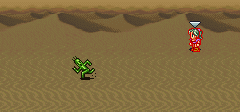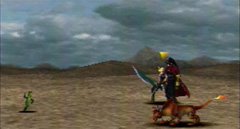
|


The first known cactuar, or 'cactrot'. |
 |
Known by many names throughout the world, the cactuar is an elusive and enigmatic species. In Japan, it has been known as "sabotender", but in America it first appeared in Final Fantasy III (or VI, Japanese) as "cactrot," and later was given the name by which I will be referring to it here, "cactuar," in Final Fantasies VII and VIII.
Nearly the exact opposite of tonberries in temperment, the cactuar favors wide open spaces, particularly hot, dry deserts and rocky areas with plenty of sun. This is due to two reasons: The cactuar is a small, mobile form of cactus, and the creatures are very highstrung and nervous. No doubt they like to be able to see any danger coming from a long way off, and having several different directions to escape in helps as well.
 |

A cactuar battles a group of adventurers. |
Escaping, in fact, is what the cactuar is known best for. When encountered by humans, often a cactuar will not stick around until he decides whether or not they mean him harm before he scurries off to find a hiding place. Even if someone does manage to make a move towards it, the cactuar is such a fast creature that it will almost certainly dodge. But don't be fooled - a cactuar can be a deadly enemy if provoked. If a cactuar is sufficiently frightened, it shoots thousands of needles from its body as a reflex. Depending on how long the cactuar has lived and how large it is, this last ditch attack can do a considerable amount of damage. Recently one cactuar was discovered which had grown nearly twenty feet tall over many years, and its attack was powerful enough to kill a man with a single hit.
This self-defense technique and the speed of the cactuar are the sole reasons the species has not died out already, as they are incredibly weak and not particularly intelligent. Now it has become popular to hunt cactuars for their thorns, and the cactuar population has diminished greatly. Though hard to hit, one moderate blow is enough to kill a cactuar, and contact with water is almost always deadly. Since they populate barren deserts and rocky, uninhabitable lands, it is thought that they depend solely on the process of photosynthesis for sustenance. No one knows if they have any sort of organized society, but many believe that it is possible, since cactuars tend to travel in packs. If that is the case, there may be a much larger population of cactuars than is currently recorded.

A group of cheerful cactuars in their natural habitat. |
 |
So why should you adopt a cactuar? They may be weak and cowardly to the casual eye, but when given reassurance and attention, the shy creature becomes affectionate and devoted. The needles that it shoots when frightened are retractable, and if the cactuar feels safe, you can hug him without feeling a single prickle. With some encouragement, he may even be able to conquer his nervous demeanor and become your protector. As long as you allow him plenty of sunlight and never, ever get him wet, your cactuar will flourish and grow larger, stronger, and more lovable year by year.

|
|





